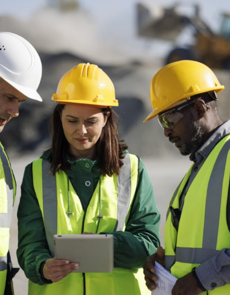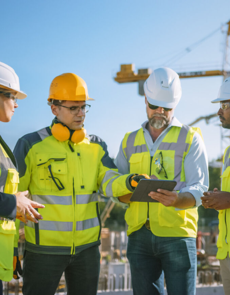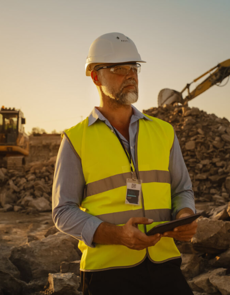Generative AI in Construction: Definition, Benefits and Challenges
Generative AI in construction has the potential to fix decades-old productivity problems caused by slow technology adoption and labor shortages.
While ‘traditional’ AI focuses on recognizing patterns and automating tasks, ‘generative’ AI can create new solutions by ‘learning’ from large datasets. When applied to construction, generative AI may be able to produce entire building designs, schedules, and resource plans.
This guides examines the rise of generative AI in construction and considers what it could mean for the sector.
What is Generative AI in Construction?
Generative AI in the construction industry is an evolved form of AI with the ability to create new designs and solutions by ‘learning’ from vast datasets. It has the ability to generate novel outputs tailored to specific project needs—everything from construction scenarios to budget forecasts.
While lumping generative AI with traditional AI might be easy, the truth is a bit more complicated. Generative AI learns from unstructured data to generate original content. It can rapidly optimize material choices and automate many project requirements—tasks that would take humans days, if not weeks, to complete.
Examples of Generative AI in Construction
Generative AI could automate and optimize processes across the construction project lifecycle, from design to facility administration.
Design Tools
With generative AI, users can create and iterate on building models based on user-defined parameters in seconds. Platforms use generative AI to create floor plans and adjust layouts as project requirements change, and give instant feedback on efficiency, compliance, and sustainability.
Architects and engineers can explore many design options, optimize for cost and performance, and ensure compliance before construction starts.
These tools are easy-to-use because they can automatically account for zoning laws, codes, climate considerations, and material constraints.
For example, the AI-powered platform from ARCHITECHTURES optimizes building designs for cost and energy efficiency by analyzing various criteria, such as solar exposure and structural viability. It speeds up the preconstruction stage, leading to faster project starts, reduced planning expenses, and more creative freedom in the design process without sacrificing accuracy.
Project Scheduling
Generative AI can allow construction project managers to automatically reschedule jobs, modify timetables, and view multiple ‘what-if’ scenarios based on data inputs. Generative AI can present various scheduling scenarios by examining past data, present project requirements, and resource availability.
An increasing amount of construction project management software now employs AI to generate optimized construction schedules based on user-defined rules, objectives and constraints.
These technologies assist construction project managers in continually responding to changes by simulating many possible schedules and choosing the best solution, helping projects remain on schedule.
Procurement
Construction procurement specialists could be able to resolve blockers using generative AI. Construction supply chain management software can use generative AI to generate purchase orders, requisitions, and proposals in minutes. Instead of spending weeks comparing supplier proposals, reviewing pricing benchmarks, or flagging contract terms, procurement managers could delegate the bulk of these tasks to AI.
The result is the same: completed essential tasks that move the project forward. However, procurement professionals are able to instead focus on strategic tasks and relationship building, rather than compliance.
Resource Allocation
By processing both real-time and historical data, generative AI can predict material needs, schedule labor, and manage equipment to optimize resource allocation across construction projects.
AI-powered tools help flag inefficiencies, adjust project schedules, and closely track supply chains, so resources are available when needed, and project setbacks are reduced.
Risk Management
Generative AI, when fed accurate real-time data, could be able to handle the continuous risk monitoring of projects. Once integrated into workflows, generative AI has the power to spot risks and bottlenecks that are holding projects back.
Real-time mitigation techniques, proactive safety measures, and scenario simulations contribute to fewer accidents, improved compliance, and quicker project completion.
Cost Management and Forecasting
Generative AI can predict expenses, reactively edit budgets, and find cost-saving opportunities by analyzing massive financial datasets.
Construction financial management software such as Access Coins uses AI to help construction professionals budget their projects accurately, forecast financial risks in real-time, and track spending at every stage of a project.
Gain Visibility, Forecast Costs and Build Better with Access Coins
Access Coins is the AI-powered ERP purpose-built for construction.
What are the Benefits of Generative AI in Construction?
As generative AI advances, it will be able to transform construction workflows and reduce risks through predictive analysis. When applied correctly, it could represent a new era of innovation and sustainability for the construction sector.
Closing the Productivity Gap
According to a McKinsey report, generative AI could increase construction productivity by up to 20% through better project scheduling and resource management. Additionally, 3D modeling and AI-driven predictive analytics can improve the accuracy of project and cost plans – leading to fewer project delays.
Cost Control
When applied to construction technology, generative AI provides accurate, data-driven insights, optimizes material usage, and uncovers savings opportunities throughout the project lifecycle.
AI-driven software can continuously monitor expenditures and performance, providing early warnings of budget overruns and enabling real-time, dynamic cost adjustments.
Leaders can also cut costs without sacrificing quality with AI-driven construction cost management tools. Generative AI can help project managers find alternative construction methods, materials, or workflows that keep design intent while lowering costs based on historical project data, benchmarks, and material substitutions.
For example, AI might recommend switching to a prefabricated component to reduce on-site labor hours or point out a supplier with cheaper materials.
Easing the Pressure of the Labor Shortage
The U.S. construction industry is grappling with a significant labor gap. Generative AI reduces this pressure this by automating repetitive tasks like data-entry, scheduling, and reporting - reducing the need for large workforces.
It also helps upskill and onboard new workers faster, generating tailored training materials and automating the transfer of institutional knowledge across teams.
Better Resource Allocation
Generative AI optimizes construction resource allocation by analyzing real-time labor, equipment, and materials data. AI-powered scheduling algorithms can also take weather, delivery delays, on-the-ground resource availability and other variables into consideration - leading to more adaptive project planning.
What are the Challenges of Generative AI in Construction?
Generative AI can certainly benefit the construction industry, but it is not a cure-all. Adoption requires investment, a cultural shift, and strategic planning, particularly in a traditionally older workforce.
Resistance to Change
Construction has a strong and specific culture, particularly among seasoned leaders who started their careers using pen and paper. Many experienced construction employees will be wary of new technology because of worries around moving away from tried-and-tested approaches.
It takes more than technical training to overcome this resistance. It's important to foster a culture of innovation and communicate generative AI's tangible benefits (like fewer safety incidents and less paperwork), and showcase how AI augments rather than replaces their skills.
Clear incentives for early adopters, experimental initiatives, and peer-led training can all help close the trust gap and hasten buy-in at all organizational levels.
Dependence on Good Data
The efficiency of generative AI depends on having access to centralized, high-quality, organized data. Construction data is often fragmented across multiple platforms, spreadsheets, and legacy systems, leading to inconsistencies and errors that can undermine AI outputs.
Poor data fed to generative AI leads to inaccurate recommendations. To address this, firms must invest in robust data management practices, like cleaning legacy data, standardizing data entry, and integrating systems via a single source of truth, like a modern construction ERP. AI-driven tools won't work without this step.
Integrating Generative AI into Existing Workflows
Many construction firms rely on legacy software and bespoke workflows which are incompatible with AI solutions. Integrating generative AI into these environments can be technically complex, requiring significant investment in IT infrastructure, system upgrades, custom integrations, and staff training.
These processes may disrupt ongoing projects and demands close collaboration between IT, operations, and field teams.
Successful integration of generative AI in construction often begins with focused pilot programs targeting high-impact use cases, like scheduling or safety monitoring, to demonstrate clear ROI.
Once proven, companies can expand adoption through phased rollouts, supported by ongoing training, documentation, and stakeholder engagement to ensure smooth implementation and long-term value.
The Construction AI Skills Gap
Using generative AI in construction is still in the early stages, and workers rarely have the skills to set up, monitor, and optimize generative AI systems.
Upskilling is crucial. Firms should invest in continuous training, partner with AI-driven vendors for knowledge transfer, and consider hiring or contracting out to AI specialists. Building internal AI literacy ensures effective tool use and empowers teams to identify new opportunities for automation and innovation.
Unlocking the Full Potential of Generative AI in Construction
Generative AI has the potential to redefine project management, design, and delivery in the construction sector.
Although this is a huge step forward, various challenges to implementing generative AI across construction includes resistance to change, data quality problems, integration complexity, and a shortage of knowledge within the industry.
With a clear plan and experienced tech partners, construction companies can overcome these obstacles and realize the full potential of generative AI.
Evaluate current data practices and digital workflows, start small with targeted AI tools in areas like scheduling, and ensure your team knows the value of using AI to future-proof operations.
After all, generative AI will not be a passing trend—it will almost certainly define the future of construction. Companies embracing generative AI today will set the pace for tomorrow.
Start Your Generative AI in Construction Journey with Access Coins
Access Coins is an integrated ERP platform purpose-built for construction that provides a single source of truth for your data across projects and teams.
Access Coins uses AI to help construction teams gain real insight from their data using role-specific dashboards, project analytics, cost forecasting and automated workflows.
Want to know more about how Access Coins could be your first step towards an AI-powered digital transformation?

 UK
UK
 AU & NZ
AU & NZ
 SG
SG
 MY
MY
 IE
IE







